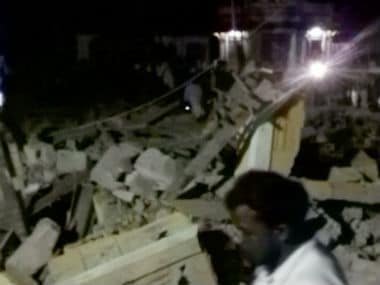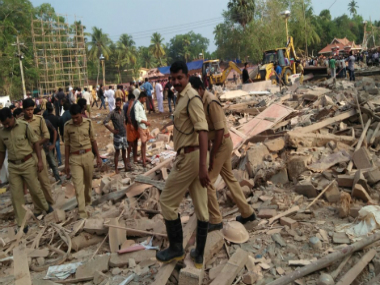The fireworks accident at a temple in the southern district of Kollam in Kerala early this morning was the deadliest in the state’s history, but it won’t be the last. Fireworks and accidents are part of Kerala’s temple festivities and they are only likely to increase because the number of temples and the scale of festivals are rising fast. The first major fireworks accident that shocked the state was way back in 1952 at the hill-shrine of Sabarimala in which 68 people died and many were maimed. Since then, there have been major accidents every now and then killing and injuring people in different parts of the state. Rough estimates show that in the last 50 plus years, there have been more than 400 such accidents and they have claimed at least an equal number of lives. The famous Thrissur pooram in northern Kerala, which is known for its multiple rounds of competitive firework displays, has been hit thrice with high casualties and injuries. But the state hasn’t learned its lessons. It’s not just the pyrotechnics that make Kerala temples veritable disaster sites during their annual festivals, but also parading elephants and overcrowding. Along with the firecracker casualties, what’s also on the rise is the loss of lives and property due to attacks by elephants that run amuck. Occasionally there have also been incidents in which people die in stampedes and on railway tracks. [caption id=“attachment_2721520” align=“alignleft” width=“380”] Rescue operations arrived at around 9:20 in the morning. Firstpost[/caption] As the Kollam tragedy and many other fireworks accidents show, it’s not just the people who are directly involved in them or those who are in the vicinity who get killed. Instead, people in the entire area are at risk. In Kollam, a lot of people died from heavy concrete debris that fell on them because the fireworks ignited a warehouse of explosives. If the devotees and people are to be protected from such disasters, the temples and their surroundings should be disaster-proofed, which in effect means that their scale and intensity have to be rationalised. Both the use of fireworks and elephants have to either stop or have to managed with extreme safeguards. That’s exactly why it will never stop because the festivals in the state are getting bigger and bigger, and both fireworks and elephants have a pride of place in their scheme of things. The bigger, grander and louder they get, the better. Local media, particularly TV channels, devote considerable time and resources to promote them, which prompts even smaller temples to go big. Now it’s quite common to see even street-corner installations and small community/family places of worship staging grand events. A 2011 media report said that in Thrissur district alone, 58 people died and 136 were injured in 76 fireworks manufacturing units in a year. The situation could have been mitigated had the local authorities and festival organisers abided by the law. On paper, nothing can go wrong because both the fireworks manufacturers and the organisers need appropriate permissions according to the rules laid out by the Petroleum and Explosives Safety Organisation of the central government. There are also guidelines on where the fireworks can be held, how people should be evacuated from such sites, and what are the safe distances to be kept. Certain chemicals and combinations (e.g. sulphur and potassium chlorates) are banned across the country, and the Kerala high court has banned the production of certain types of native explosives because they are really dangerous. But the festivals cannot do without them because the banned substances and explosives make the maximum noise and impact. More over, in most temples the fireworks are staged in cramped spaces and people get as close as they can. The most dangerous part, however, is that the organisers egg on different groups to compete with one another and make the event a test of their financial muscle and fire power. Competitive bogus gallantry fly in the face of rules and regulations and it’s a free for all. Banned substances are freely used and guidelines are flouted with impunity even as local authorities mutely watch over. Reportedly, the disastrous fireworks at the Kollam festival also was a competition between local groups. This is a fast-spreading social evil that cannot be stopped by rules and regulations, but by self-restraint. As in the case of many disastrous fireworks tragedies in the state, there was no permission for the fireworks for the Kollam temple as well. Reportedly, the district collector had said no, but the organisers went ahead because that’s what patrons of the temple wanted. The district administration, with the help of the local police, could have taken action, but either they ignored the risks or were overcome by the popular interest. Had they inspected the sites, read the rules to the organisers and prevented unlawful manufacture of the explosives, the loss of lives and properties could have been avoided. [caption id=“attachment_2721274” align=“alignright” width=“380”]
 Many people were killed after an explosion took place at the Puttingal temple in Kollam, Kerala. AP[/caption] The same goes with the misuse of elephants as well. On the lines of the grand display of decorated elephants at Thrissur pooram, even small temples have been increasing the number of elephants they parade during their festivals. In places where even one elephant can create a traffic-jam, organisers line up three or more and they are made to stand in maddening sounds of loudspeakers, crowds, music and firecrackers for hours on end. On many occasions, they run amuck. Although there are no reliable official statistics, reports in mainstream and social media show that the incidence of elephants killing people and damaging property is certainly on the rise and most of them are associated with temples. It’s high time that people realised that their show of strength and pomp shouldn’t be at the risk of their own lives. Nowhere in the advanced world pyro-techniques are handled like this. Much grander and stunning fireworks are staged in different parts of the world every day without any casualty because they adhere to modern technology and regulatory practices. Setting off deafening explosives made using dangerous chemicals to show one’s muscle and piety is suicidal. And it’s happening year after year. It’s a race to the bottom. So, next time you set out to watch big “gundus” (bomb-like explosives banned by the Kerala high court, but freely used in temple fireworks) going off in your nearby temple, remember that burn injuries are really hard to treat and there may not be an expert within a 50-100 km radius.
This is a fast-spreading social evil that cannot be stopped by rules and regulations, but by self-restraint. As in the case of many disastrous fireworks tragedies in Kerala, there was no permission for the fireworks for the Kollam temple as well
Advertisement
End of Article


)

)
)
)
)
)
)
)
)



